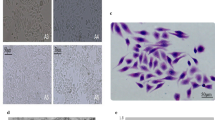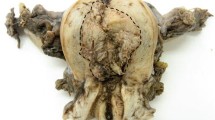Abstract
We examined a 32-year-old Japanese man who was clinically diagnosed with gastric cancer, type 4, and histopathologically diagnosed with mucinous and poorly differentiated adenocarcinoma (mucinous > poorly) of the stomach. We successfully established and characterized a cell line (designated as IGSK-2) derived from the ascitic fluid of the patient with recurrent and cisplatin-resistant carcinoma. The IGSK-2 cells grew in multi-layered culture in culture dishes. The cells secreted 1 8 pg/mL somatostatin, 9.1 mIU/mL human chorionic gonadotrophin (hCG), 8000 U/mL carbohydrate antigen 19-9 and 410 ng/mL carcinoembryonic antigen over 4 days of culture. The population doubling time was approximately 83 h. The susceptibility test of anticancer drugs revealed that IGSK-2 cells were sensitive to Taxol, but were not sensitive to cisplatin, 5-fluorouracil and irinotecan. Immunohistochemical staining revealed that the IGSK-2 cells were positive against antihCG antibody and antiserotonin antibody, and negative against antisomatostatin antibody and antigastrin antibody.
Similar content being viewed by others
References
Ueda M, Fujiwara Y, Murakami A et al. Establishment of a CSF-producing cell line from a human gastric carcinoma and characteristics of the CSF produced by that cell line. Int J Cell Cloning 1987; 5: 322–34.
Akiyama S, Amo H, Watanabe T et al. Characteristics of three human gastric cancer cell lines, NU-GC-2, NU-GC-3 and NU-GC-4. Jpn J Surg 1988; 18: 438–46.
Terano A, Nakada R, Mutoh H et al. Establishment and characterization of a tumor marker producing cell line (JR-1) derived from a gastric scirrhous cancer. Hum Cell 1989; 2: 307–9 (in Japanese).
Terano A, Nakada R, Hiraishi H et al. Establishment of a new cell line derived from human gastric adenocarcinoma, producing tumor markers. Gastroenterol Jpn 1989; 24: 219.
Park JG, Frucht H, LaRocca RV et al. Characteristics of cell lines established from human gastric carcinoma. Cancer Res 1990; 50: 2773–80.
Whitehead RH, Novak U, Thomas RJ et al. A new gastric carcinoma cell line (LIM1839) derived from a young Caucasian male. Int J Cancer 1989; 44: 1100–3.
Nockel J, van den Engel NK, Winter H et al. Characterization of gastric adenocarcinoma cell lines established from CEA424/SV40 T antigen-transgenic mice with or without a human CEA transgene. BMC Cancer 2006; 6: 57.
de Both NJ, Wijnhoven BP, Sleddens HF et al. Establishment of cell lines from adenocarcinomas of the esophagus and gastric cardia growing in vivo and in vitro. Virchows Arch 2001; 438: 451–6.
Yamaguchi K, Ura H, Yasoshima T et al. Establishment and characterization of a human gastric carcinoma cell line that is highly metastatic to lymph nodes. J. Exp Clin Cancer Res 2000; 19: 113–20.
Kaneko K, Yano M, Tsujinaka T et al. Establishment of a visible peritoneal micrometastatic model from a gastric adenocarcinoma cell line by green fluorescent protein. Int J Oncol 2000; 16: 893–8.
Yasoshima T, Denno R, Kawaguchi S et al. Establishment and characterization of human gastric carcinoma lines with high metastatic potential in the liver: changes in integrin expression associated with the ability to metastasize in the liver of nude mice. Jpn J Cancer Res 1996; 87: 153–60.
Amano Y, Okumura C, Yoshida M et al. Measuring respiration of cultured cell with oxygen electrode as a metabolic indicator for drug screening. Hum Cell 1999; 12: 3–10.
Uesu K, Ishikawa H. Analysis of susceptibility test of anticancer drugs using new types of oxygen electrodes. Bull Edu Res, Nihon Univ Sch Dent Matsudo 2002; 1: 102–15 (in Japanese).
Uesu K, Ishikawa H. Analysis of an in vitro susceptibility test of anticancer drugs using new types of oxygen electrodes. Bull Edu Res, Nihon Univ Sch Dent Matsudo 2005; 7: 7–21 (in Japanese).
Author information
Authors and Affiliations
Corresponding author
Rights and permissions
About this article
Cite this article
Ohi, S., Takahashi, N., Hashimoto, H. et al. Establishment and characterization of an IGSK-2 cell line derived from ascitic fluid of recurrent hCG and somatostatin secreted adenocarcinoma of the stomach. Hum Cell 20, 52–61 (2007). https://doi.org/10.1111/j.1749-0774.2007.00027.x
Received:
Accepted:
Published:
Issue Date:
DOI: https://doi.org/10.1111/j.1749-0774.2007.00027.x




